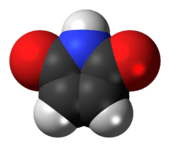Maleimide
 | |
 | |
| Names | |
|---|---|
| IUPAC name
Maleimide | |
| Other names
2,5-Pyrroledione | |
| Identifiers | |
3D model (JSmol) |
|
| ChEBI | |
| ChEMBL | |
| ChemSpider | |
| ECHA InfoCard | 100.007.990 |
PubChem CID |
|
| |
| |
| Properties | |
| C4H3NO2 | |
| Molar mass | 97.07 g/mol |
| Melting point | 91 to 93 °C (196 to 199 °F; 364 to 366 K) |
| organic solvents | |
| Hazards | |
| R-phrases (outdated) | R25 R34 R43 |
| S-phrases (outdated) | S26 S36/37/39 S45 |
Except where otherwise noted, data are given for materials in their standard state (at 25 °C [77 °F], 100 kPa). | |
| Infobox references | |
Maleimide is a chemical compound with the formula H2C2(CO)2NH (see diagram). This unsaturated imide is an important building block in organic synthesis. The name is a contraction of maleic acid and imide, the -C(O)NHC(O)- functional group. Maleimides also describes a class of derivatives of the parent maleimide where the NH group is replaced with alkyl or aryl groups such as a methyl or phenyl, respectively. The substituent can also be a small molecule (such as biotin, a fluorescent dye, an oligosaccharide a nucleic acid), a reactive group, or a synthetic polymer such as polyethylene glycol.[1] Human hemoglobin chemically modified with maleimide-polyethylene glycol is a blood substitute called MP4.
Organic chemistry
Maleimide and its derivatives are prepared from maleic anhydride by treatment with amines followed by dehydration.[2] A special feature of the reactivity of maleimides is their susceptibility to additions across the double bond either by Michael additions or via Diels-Alder reactions. Bismaleimides are a class of compounds with two maleimide groups connected by the nitrogen atoms via a linker, and are used as crosslinking reagents in thermoset polymer chemistry. Compounds containing a maleimide group linked with another reactive group, such as an activated N-hydroxysuccinimide ester, are called maleimide heterobifunctional reagents (for example, see SMCC reagent).[1]
Natural maleimides
Only a handful of natural maleimides – exemplified by the cytotoxic showdomycin from Streptomyces showdoensis,[3] and pencolide from Pe. multicolor[3] – have been reported. Farinomalein was first isolated in 2009 from the entomopathogenic fungus Isaria farinosa (Paecilomyces farinosus) – source H599 (Japan).[4]
Biotechnology applications
Maleimide-mediated methodologies are among the most used in bioconjugation.[5][6] Due to exceptionally fast reaction rates and significantly high selectivity towards cysteine residues in proteins, a large variety of maleimide heterobifunctional reagents are used for the preparation of targeted therapeutics, assemblies for studying proteins in their biological context, protein-based microarrays, or proteins immobilisation.[7] For instance, emerging promising targeted drug therapies, antibody-drug conjugates, are constituted of three main components: a monoclonal antibody, a cytotoxic drug, and a linker molecule often containing a maleimide group, which binds the drug and the antibody.[8]
Maleimides linked to polyethylene glycol chains are often used as flexible linking molecules to attach proteins to surfaces. The double bond readily reacts with the thiol group found on cysteine to form a stable carbon-sulfur bond. Attaching the other end of the polyethylene chain to a bead or solid support allows for easy separation of protein from other molecules in solution, provided these molecules do not also possess thiol groups.
Technological applications
Mono- and bismaleimide-based polymers are used for high temperature applications up to 250 °C.[9] Maleimides linked to rubber chains are often used as flexible linking molecules to reinforce the rubber (tire). The double bond readily reacts with all hydroxy, amine or thiol groups found on the matrix to form a stable carbon-oxygen, carbon-nitrogen, or carbon-sulfur bond, respectively. Lockheed Martin's F-35B (a STOVL version of this US fighter) is reportedly composed of bismaleimide materials, in addition to the use of advanced carbon fiber thermoset polymer matrix composites.[10]
See also
References
- 1 2 Hermanson, Greg. Bioconjugate Techniques. Elsevier. p. 299–339. ISBN 978-0-12-382239-0.
- ↑ Cava, M. P.; Deana, A. A.; Muth, K.; Mitchell, M. J. (1973). "N-Phenylmaleimide". Organic Syntheses. ; Collective Volume, 5, p. 944
- 1 2 J. H. Birkinshaw, M. G. Kalyanpur and C. E. Stickings. (1963). "Studies on the biochemistry of microorganisms. 113. Pencolide, a nitrogen-containing metabolite of Penicillium multicolor Grigorievna-Manilova and poradievova". Biochem. J. 86: 237–243.
- ↑ Sastia P. Putri, Hiroshi Kinoshita, Fumio Ihara, Yasuhiro Igarashi and Takuya Nihira. "Farinomalein, a Maleimide-Bearing Compound from the Entomopathogenic Fungus Paecilomyces farinosus". J. Nat. Prod., 2009, 72 (8), pp. 1544–1546. doi:10.1021/np9002806
- ↑ Koniev, O.; Wagner, A. (2015). "Developments and recent advancements in the field of endogenous amino acid selective bond forming reactions for bioconjugation". Chem. Soc. Rev. 44 (15): 5495–5551. doi:10.1039/C5CS00048C.
- ↑ Francis, M. B.; Carrico, I. S. (2010). "New frontiers in protein bioconjugation". Current Opinion in Chemical Biology. 14 (6): 771–773. doi:10.1016/j.cbpa.2010.11.006. PMID 21112236.
- ↑ Hermanson, Greg. Bioconjugate Techniques. Elsevier. p. 1–125. ISBN 978-0-12-382239-0.
- ↑ Beck, A.; Goetsch, L.; Dumontet, C.; Corvaïa, N. (2017). "Strategies and challenges for the next generation of antibody-drug conjugates". Chem. Soc. Rev. 19 (16): 315–337. doi:10.1038/nrd.2016.268.
- ↑ Lin, K.-F.; Lin, J.-S.; Cheng, C.-H. (1996). "High temperature resins based on allylamine/bismaleimides". Polymer. 37 (21): 4729–4737. doi:10.1016/S0032-3861(96)00311-4.
- ↑ "Lockheed Martin F-35B Boasts UFO Technology, Fights For Team USA". International Science Time s. August 21, 2013. Retrieved 28 January 2014.
External links
- The MP4 website, Molecule of the Month, December 2004